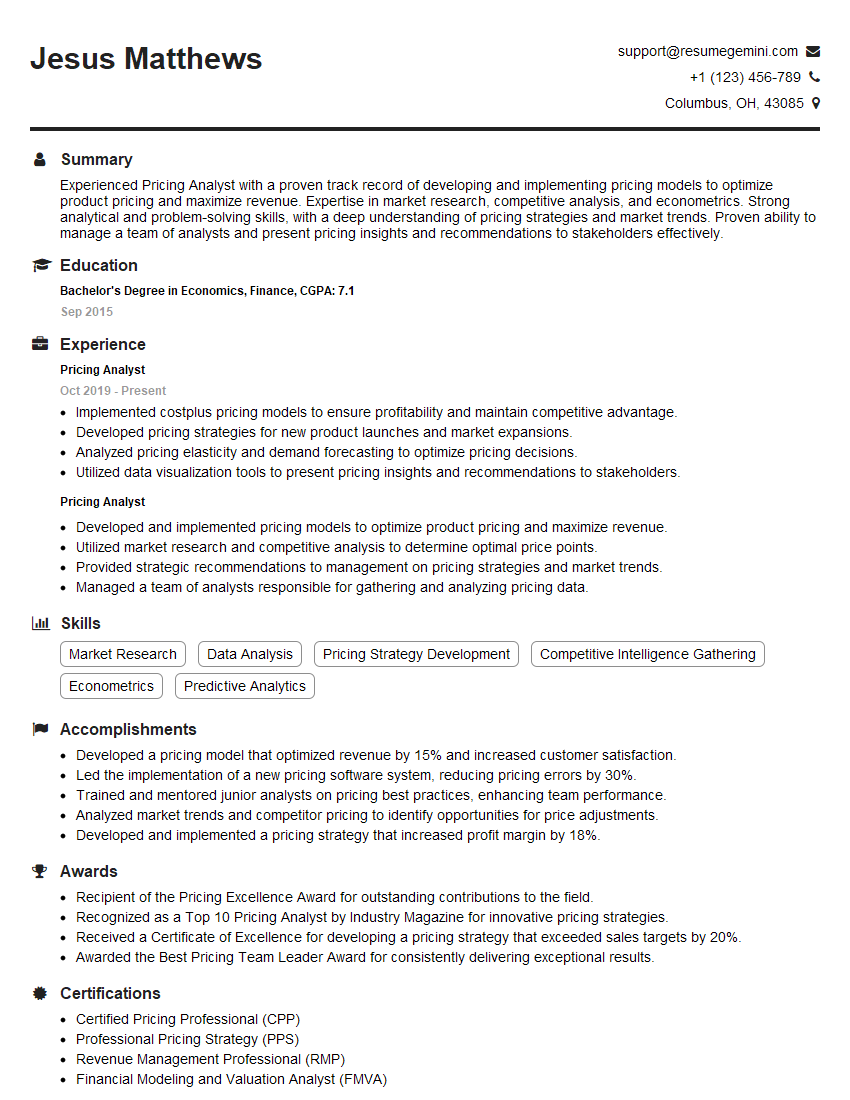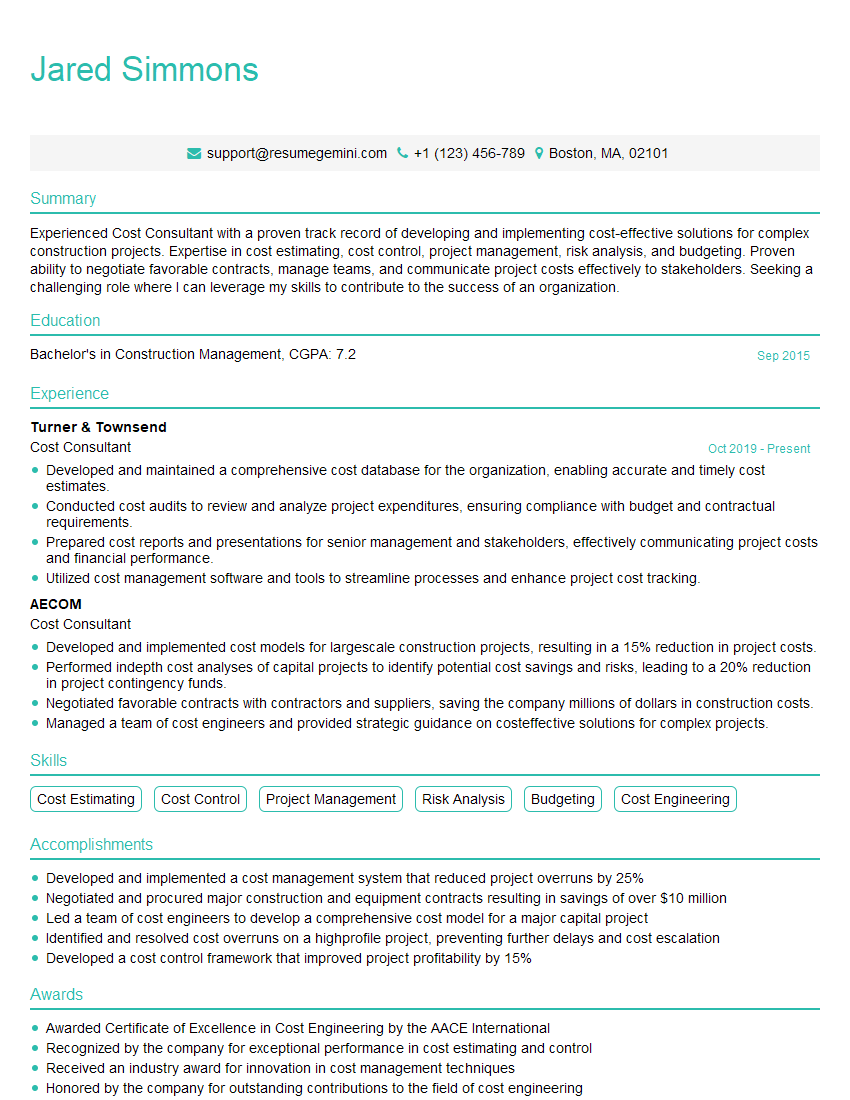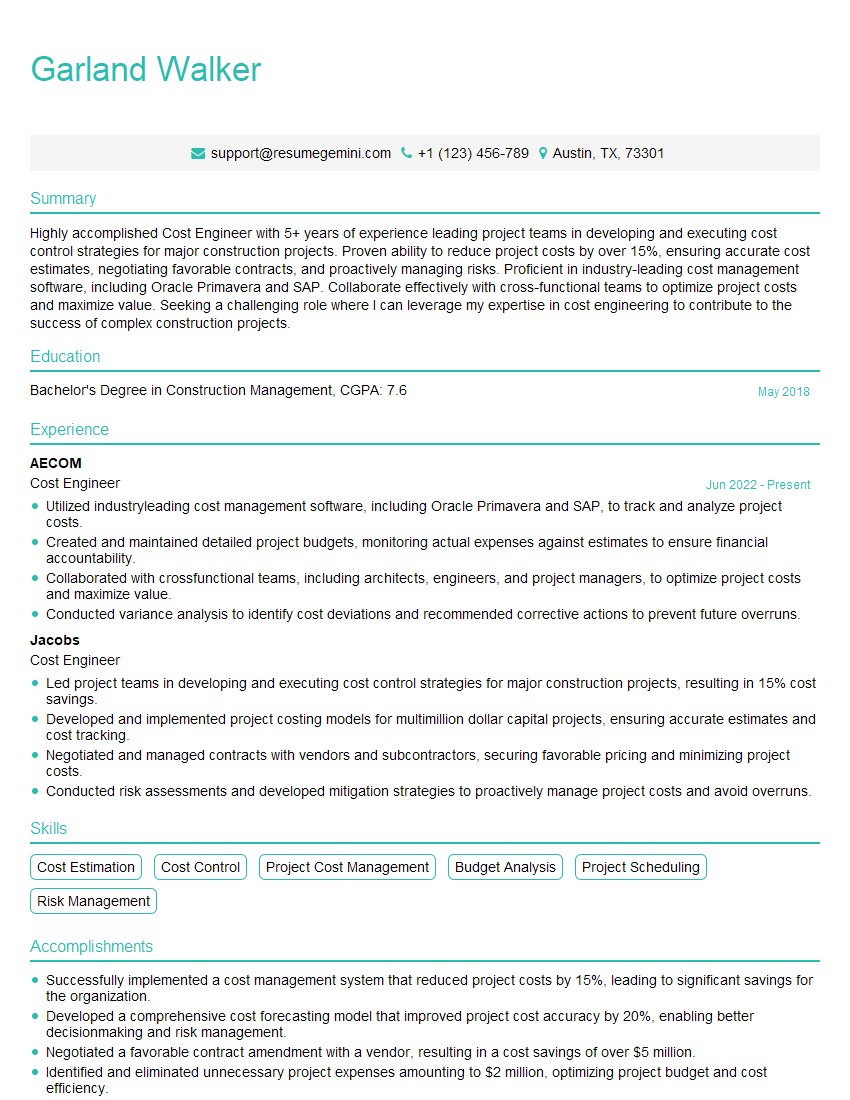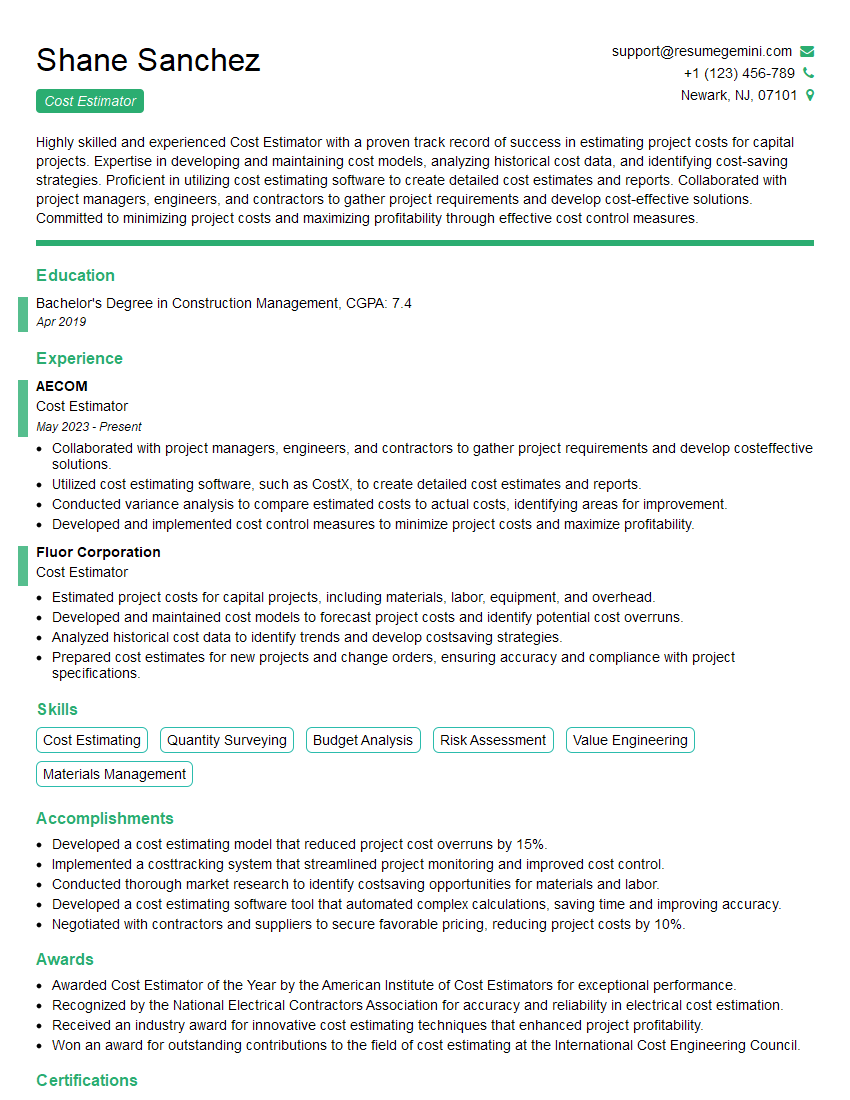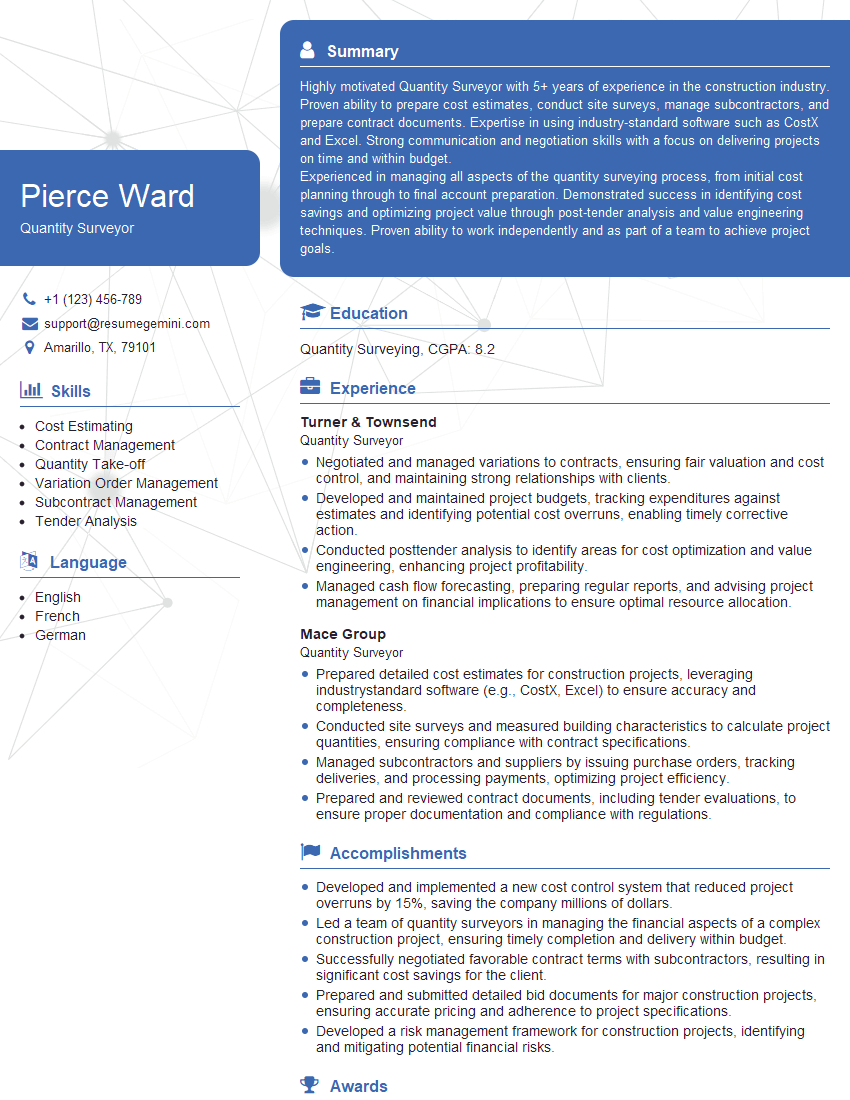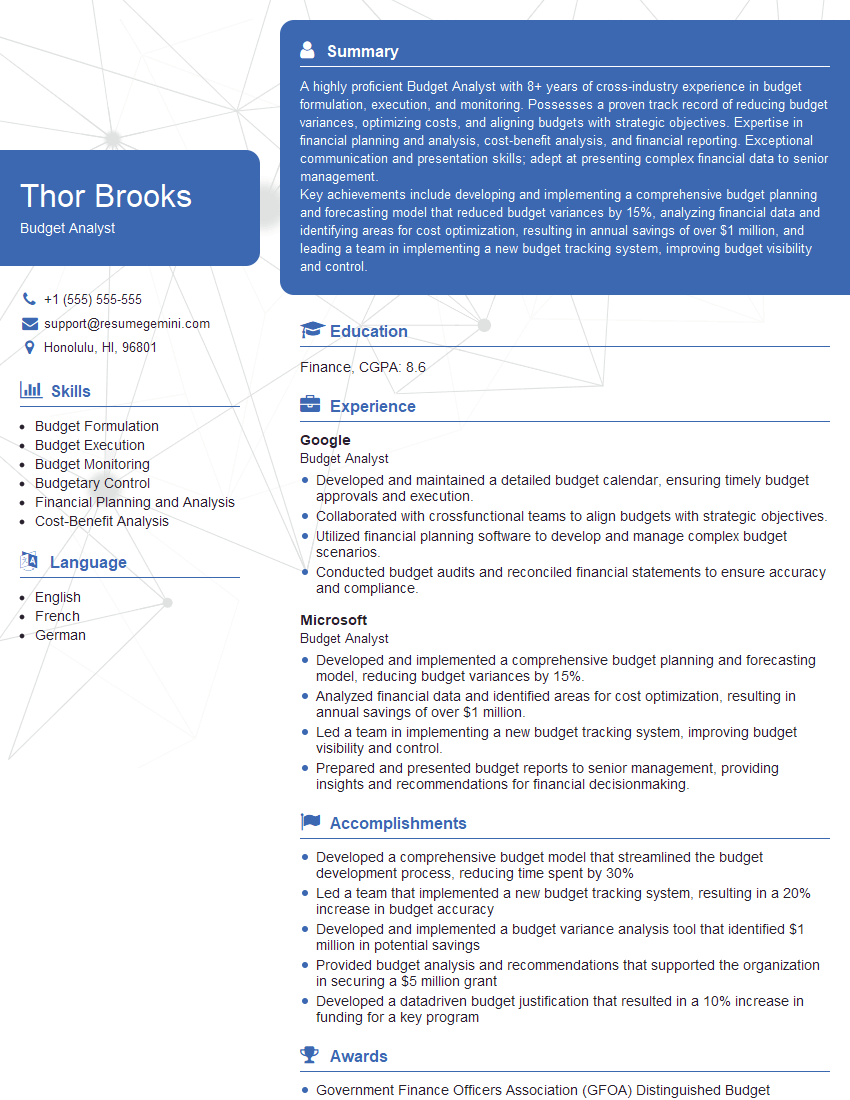The right preparation can turn an interview into an opportunity to showcase your expertise. This guide to Job Cost Estimation and Budgeting interview questions is your ultimate resource, providing key insights and tips to help you ace your responses and stand out as a top candidate.
Questions Asked in Job Cost Estimation and Budgeting Interview
Q 1. Explain the difference between direct and indirect costs.
The difference between direct and indirect costs lies in their traceability to a specific project or job. Direct costs are those that can be directly attributed to a particular project. Think of them as the ‘ingredients’ of your project. Indirect costs, on the other hand, are those that support multiple projects but can’t be easily traced to a single one. These are the ‘overhead’ costs.
- Direct Costs Examples: Raw materials used in manufacturing, labor directly involved in building a house, specific software licenses for a software development project.
- Indirect Costs Examples: Rent of the office space, salaries of administrative staff, utilities (electricity, water), insurance premiums.
Imagine building a house. Direct costs include the bricks, cement, lumber, and the wages of the construction workers. Indirect costs would include the project manager’s salary (who oversees multiple projects), the cost of office supplies, or the rent for the construction company’s office. Clearly identifying these different cost types is crucial for accurate job costing and profitability analysis.
Q 2. Describe the various methods used for job cost estimation.
Several methods exist for estimating job costs, each with its strengths and weaknesses. The choice depends on the project’s nature, available data, and the desired accuracy level. Here are a few common methods:
- Bottom-Up Estimating: This method involves breaking down the project into its smallest components and estimating the cost of each component. It’s highly detailed and accurate but time-consuming. Think of creating a detailed recipe for a dish – every ingredient and step must be carefully considered.
- Top-Down Estimating: This method uses historical data or industry benchmarks to estimate the overall project cost. It’s faster and simpler than bottom-up, but less precise. This is like estimating the cost of a dish based on similar dishes you’ve cooked before, without detailed ingredient lists.
- Parametric Estimating: This method uses statistical relationships between project parameters (like size, weight, complexity) and cost to estimate the total cost. It’s effective for large projects with similar historical data. For example, estimating the cost of building a similar building based on the size and cost of a previously built building.
- Expert Opinion: While not a method in itself, gathering expert opinions is often crucial in early-stage estimation, providing a high-level cost overview and risk assessments. It adds context to the numbers.
Often, a combination of these methods is used for a more robust estimate. For instance, you might use top-down for a preliminary estimate and then refine it with bottom-up for critical components.
Q 3. What are the key components of a comprehensive budget?
A comprehensive budget should include several key components to provide a holistic financial plan. These components are interconnected and should be consistently reviewed and adjusted throughout the project lifecycle.
- Revenue Projections: Forecasted income from the project, based on anticipated sales or deliverables.
- Direct Costs: Detailed breakdown of all direct costs associated with the project, including materials, labor, and subcontractors.
- Indirect Costs: Allocation of overhead expenses like rent, utilities, and administrative salaries.
- Profit Margin: The desired profit percentage to be achieved on the project.
- Contingency Reserves: Funds set aside to cover unforeseen expenses or risks.
- Timeline: A schedule indicating when different expenses will be incurred and revenue will be generated.
- Key Performance Indicators (KPIs): Metrics to track progress and measure performance against the budget, enabling proactive adjustments.
A well-structured budget allows for informed decision-making, resource allocation, and performance monitoring, ensuring the project stays within financial parameters.
Q 4. How do you handle cost overruns in a project?
Cost overruns are a common challenge in project management. Addressing them requires a structured approach:
- Identify the Cause: Thoroughly investigate the reasons for the overrun. Was it due to inaccurate estimation, unforeseen circumstances, changes in scope, or poor resource management? Pinpointing the root cause is critical for finding a solution.
- Quantify the Overrun: Precisely determine the extent of the overrun and its impact on the project’s overall financial health.
- Develop Mitigation Strategies: Depending on the cause, develop strategies to bring the project back on track. This might involve negotiating with vendors, optimizing resource allocation, re-scoping the project, or seeking additional funding.
- Communicate and Document: Transparent communication with stakeholders (clients, management) is essential. Document all decisions, adjustments, and justifications for changes to the original budget.
- Implement Corrective Actions: Put mitigation strategies into action and monitor their effectiveness. Adapt the approach as needed. Implement preventative measures to avoid similar issues in future projects. This might involve improved estimation techniques, enhanced risk management, or better project tracking systems.
A proactive and transparent approach to cost overruns minimizes their impact and ensures project success.
Q 5. Explain the concept of variance analysis in cost management.
Variance analysis is a crucial process in cost management. It involves comparing planned (budgeted) costs with actual costs to identify deviations (variances). This analysis helps understand why costs differ from expectations and make informed decisions to improve future performance.
Types of Variances:
- Favorable Variance: Actual costs are lower than budgeted costs.
- Unfavorable Variance: Actual costs are higher than budgeted costs.
Analyzing Variances:
Variance analysis often focuses on individual cost elements (materials, labor, overhead) to pinpoint specific areas of overspending or underspending. For example, a significant unfavorable variance in material costs could indicate inaccurate initial estimates, higher-than-expected material prices, or waste during the project. A thorough investigation into these areas enables corrective actions and prevents similar issues in future projects.
Tools and Techniques:
Spreadsheet software, project management software, and statistical techniques can all be utilized in variance analysis. For example, (Actual Cost - Budgeted Cost) / Budgeted Cost * 100% provides the variance percentage.
Q 6. What are some common challenges in job cost estimation?
Job cost estimation faces several challenges that can lead to inaccuracies and ultimately, project failure. Some of the most common include:
- Inaccurate Forecasting: Unforeseen changes in material prices, labor rates, or project scope can significantly impact costs.
- Incomplete Information: Lack of detailed information about the project during the initial stages makes accurate cost estimation difficult.
- Hidden Costs: Unexpected costs can arise during the project lifecycle, often due to underestimated complexity, unforeseen issues, or delays.
- Difficulty in Allocating Indirect Costs: Fairly allocating indirect costs to multiple projects can be challenging, and inaccurate allocation can distort the true cost of individual projects.
- Changes in Project Scope: Uncontrolled or poorly managed changes in project requirements can lead to significant cost overruns.
- Lack of Historical Data: Insufficient or unreliable historical data makes using parametric or top-down estimation methods challenging.
Addressing these challenges requires robust planning, meticulous data collection, experienced estimators, and flexible budgeting processes.
Q 7. How do you allocate indirect costs to projects?
Allocating indirect costs to projects is crucial for accurate job costing but can be complex. Several methods exist, each with advantages and disadvantages:
- Direct Allocation: Directly assigning indirect costs based on the direct costs of each project. For example, if a project’s direct costs make up 20% of the total direct costs, it would receive 20% of the overhead costs.
- Activity-Based Costing (ABC): This method allocates indirect costs based on the consumption of resources or activities. It provides a more accurate cost allocation than simpler methods because it considers various factors contributing to indirect costs. For instance, a project needing more design revisions would receive a higher allocation of design department’s overhead cost.
- Departmental Allocation: Indirect costs are allocated based on the labor hours spent by each project’s team in a specific department. This is quite common in organizational settings.
The best method depends on the complexity of the organization and the level of detail required. ABC tends to be more accurate, but it also requires more data and analysis. Regardless of the method chosen, consistency and transparency are essential to ensure the fair and reasonable allocation of indirect costs.
Q 8. Describe your experience using cost accounting software.
Throughout my career, I’ve extensively used various cost accounting software packages, including industry-standard solutions like QuickBooks Enterprise, Deltek Vision, and SAP Business One. My experience spans from basic data entry and report generation to advanced functionalities such as customizing reports for specific project needs, integrating the software with other business systems (like CRM or ERP), and developing complex cost allocation methodologies within the software framework. For example, in a previous role at a construction company, I utilized Deltek Vision to track labor costs, material expenses, and equipment usage across multiple concurrent projects. This allowed us to generate real-time cost reports, identify potential cost overruns early on, and ultimately improve our project profitability. I’m comfortable with both cloud-based and on-premise solutions and adapt quickly to new software.
Q 9. How do you track and manage project costs effectively?
Effective project cost tracking and management relies on a multi-faceted approach. First, a robust system for collecting and categorizing all project-related expenses is crucial. This often involves creating a detailed work breakdown structure (WBS) to break down the project into smaller, manageable tasks, each with its own budget. Second, regular monitoring against the budget is essential, typically using a combination of automated reports and manual review. I use a system of regular (weekly or bi-weekly) progress meetings to review actuals against planned costs. This allows us to identify variances promptly. Third, proactive management of changes is key; any deviations from the original plan must be properly documented, costed, and approved before implementation. This ensures costs are controlled and not spiraling out of control. Finally, a thorough post-project analysis is vital to identify areas for improvement in future projects. For instance, I once used a simple spreadsheet system to meticulously track expenditures for a small-scale web design project and realized that our initial time estimates for a certain development phase were significantly off. This informed our approach to estimating tasks on similar projects.
Q 10. Explain the importance of accurate cost estimation.
Accurate cost estimation is the cornerstone of successful project management. Without it, projects are significantly more likely to experience cost overruns, delays, and even failure. Accurate estimates allow for realistic budgeting, informed decision-making, and proper resource allocation. For example, an inaccurate estimate that underestimates the labor costs for a software development project might lead to the project being understaffed, causing delays that end up costing more than proper initial estimation would have. Conversely, an overestimation can lead to unnecessarily high bids, potentially losing clients or resulting in a project becoming unprofitable despite completion. Accurate estimation provides a solid foundation for negotiating contracts, securing funding, and demonstrating financial viability to stakeholders. It also helps in risk mitigation by identifying potential cost drivers and developing contingency plans.
Q 11. What are some strategies for reducing project costs?
Reducing project costs requires a strategic approach focusing on several key areas. One strategy is to optimize resource allocation. This involves carefully evaluating the need for personnel, materials, and equipment, and ensuring their efficient use. Another is exploring alternative materials or technologies; sometimes less expensive options can be found that maintain quality. Value engineering is another critical technique, where you systematically examine each aspect of the project to identify ways to reduce costs without sacrificing quality or functionality. For example, substituting a less expensive, yet equivalent, material in construction without impacting the structural integrity. Process optimization involves streamlining workflows to improve efficiency and reduce wasted time and resources. Finally, preventative maintenance can reduce costly repairs and downtime in the long run. In a previous project, implementing a more efficient scheduling system saved us significant labor costs.
Q 12. How do you ensure the accuracy of cost estimates?
Ensuring the accuracy of cost estimates involves a multi-step process. First, a thorough understanding of the project scope is fundamental. This requires detailed documentation and a clear definition of deliverables. Second, historical data from similar projects is extremely valuable in providing a benchmark. Third, I incorporate various estimation techniques, including parametric estimating (using historical data and statistical models), bottom-up estimating (breaking the project down into individual tasks and estimating each), and three-point estimating (using optimistic, pessimistic, and most likely estimates to account for uncertainty). It’s also crucial to factor in contingencies to account for unforeseen circumstances and risks. Finally, regular review and adjustments to the estimates throughout the project lifecycle are needed to account for any changes in scope or unforeseen circumstances. A thorough peer review of the estimates is also very beneficial in catching potential errors or omissions.
Q 13. What is your approach to developing a realistic project budget?
Developing a realistic project budget begins with a thorough cost estimate, which is then reviewed and refined through collaboration with stakeholders. I generally start with a high-level overview of all anticipated costs, categorized appropriately (labor, materials, equipment, etc.). This is then broken down into more detailed line items, ensuring each cost is justified and supported by evidence. Contingency reserves are strategically included to handle unforeseen expenses. The budget should align with the project’s overall objectives and the client’s expectations. In addition to direct costs, indirect costs (like overhead and administration) are also considered. The finalized budget is documented clearly and transparently, outlining all assumptions, risks, and potential cost drivers. In one project, we used a phased budgeting approach, which allowed us to review and adjust the budget as we progressed through each project phase, greatly enhancing realism and accuracy.
Q 14. How do you communicate cost information to stakeholders?
Communicating cost information to stakeholders requires a clear, concise, and tailored approach. I use a variety of methods, including regular progress reports (with graphical representations like charts and graphs to highlight key information), face-to-face meetings to discuss progress and address concerns, and formal presentations for key milestones or decision points. The complexity of the information is matched to the audience; technical details are provided to the project team while higher-level summaries suffice for executive stakeholders. I also utilize visual aids such as dashboards and graphs to simplify complex data and facilitate understanding. Open communication is key; I actively encourage questions and feedback, ensuring that everyone is informed and on the same page regarding project costs. Transparency builds trust and fosters a collaborative environment.
Q 15. How do you handle changes in project scope and their impact on costs?
Handling scope changes effectively is crucial for successful project cost management. Think of it like building a house – if the client decides mid-construction to add a second story, the original budget will be blown. My approach involves a formal Change Management process. First, any proposed change is documented with a clear description, its impact on the timeline and budget, and the necessary resources. Then, a thorough cost-benefit analysis is performed. This involves evaluating the additional costs (labor, materials, time) against the value the change brings to the project. We use tools like Earned Value Management (EVM) to assess the change’s impact on the overall schedule and budget. If approved, the change is incorporated into the project plan with updated cost and schedule baselines. This ensures transparency and accountability throughout the process. We also regularly communicate these changes to the stakeholders to keep them informed and ensure their buy-in.
For instance, I once worked on a software development project where the client requested a significant feature addition halfway through. We documented the change request, estimated the additional development time (about 3 weeks), testing (1 week), and potential resource needs (one senior developer). After approval, we updated the project plan, budget, and schedule, and communicated this to the client. The transparent process prevented unexpected cost overruns and maintained a positive client relationship.
Career Expert Tips:
- Ace those interviews! Prepare effectively by reviewing the Top 50 Most Common Interview Questions on ResumeGemini.
- Navigate your job search with confidence! Explore a wide range of Career Tips on ResumeGemini. Learn about common challenges and recommendations to overcome them.
- Craft the perfect resume! Master the Art of Resume Writing with ResumeGemini’s guide. Showcase your unique qualifications and achievements effectively.
- Don’t miss out on holiday savings! Build your dream resume with ResumeGemini’s ATS optimized templates.
Q 16. What metrics do you use to monitor cost performance?
Monitoring cost performance requires a robust set of metrics. It’s like monitoring your finances – you wouldn’t just look at your total spending; you’d break it down into categories to understand where your money is going. We use a combination of:
- Cost Variance (CV): This is the difference between the budgeted cost and the actual cost (CV = Earned Value (EV) – Actual Cost (AC)). A positive CV indicates we’re under budget, while a negative CV means we’re over budget.
- Schedule Variance (SV): Measures the difference between planned progress and actual progress (SV = EV – Planned Value (PV)). This helps identify if delays are contributing to cost overruns.
- Cost Performance Index (CPI): Shows the efficiency of cost spending (CPI = EV/AC). A CPI greater than 1 implies we’re getting more value per dollar spent, while less than 1 means we’re spending more than planned.
- Schedule Performance Index (SPI): Indicates the efficiency of schedule progress (SPI = EV/PV). Similar to CPI, a value greater than 1 is favorable.
- Budget at Completion (BAC): The total budget planned for the project. Comparing this to the estimate at completion (EAC) gives an idea of potential cost overruns.
These metrics are regularly tracked and reported to stakeholders, enabling proactive identification and mitigation of cost issues.
Q 17. Describe your experience with different budgeting methods (e.g., zero-based budgeting).
I’ve worked with various budgeting methods, each with its strengths and weaknesses. Zero-based budgeting, for example, requires justifying every expense from scratch each budgeting cycle. It’s like starting your budget from zero each year, meticulously justifying every single item. While it can lead to greater efficiency by eliminating unnecessary expenses, it can be time-consuming and resource-intensive, especially for large projects. I find it most suitable for organizations that need tighter control over expenditures or those undergoing significant restructuring.
Other methods include:
- Incremental Budgeting: This is a simpler method that uses the previous year’s budget as a base and adjusts it for inflation and anticipated changes. It’s quicker but may not be as efficient in identifying waste.
- Top-Down Budgeting: Senior management sets the overall budget, then delegates allocation to lower levels. This is faster but can lack detailed insights from those doing the work.
- Bottom-Up Budgeting: Individual teams or projects estimate their needs, which are then aggregated into an overall budget. This offers better detail but can be prone to padding.
The best method depends on the project’s complexity, organizational structure, and risk tolerance. Often, a hybrid approach, combining elements of different methods, is most effective.
Q 18. How do you integrate cost estimation with project scheduling?
Integrating cost estimation with project scheduling is critical for accurate project planning and control. It’s like mapping out a road trip – you need to know not only the distance to each destination but also the cost of gas, tolls, and accommodation. We typically use software tools that allow for this integration. These tools enable linking cost estimates to specific tasks within the project schedule. This allows for tracking the cost of each task as the project progresses and for identifying potential cost overruns early on.
For example, in a construction project, each task (e.g., foundation, framing, roofing) will have an associated cost estimate based on material, labor, and equipment costs. These estimates are integrated into the project’s Gantt chart, showing the cost profile over the project’s duration. This enables managers to identify potential bottlenecks or cost issues early on and take corrective actions.
Q 19. What are some best practices for cost control?
Effective cost control is crucial for project success. It’s like managing your personal finances – careful planning and monitoring are essential. Some best practices include:
- Detailed Cost Estimation: Accurate and comprehensive estimates at the beginning are crucial. Use historical data, industry benchmarks, and detailed breakdowns.
- Regular Monitoring and Reporting: Track expenses against the budget frequently and generate regular reports for stakeholders.
- Change Management Process: Implement a well-defined process for evaluating and managing project scope changes.
- Risk Management: Identify and assess potential risks and develop mitigation strategies. Include contingency reserves in the budget for unexpected events.
- Value Engineering: Regularly review the project to find opportunities to reduce costs without sacrificing quality or functionality.
- Effective Communication: Keep stakeholders informed about the project’s financial status and any potential issues.
By consistently implementing these practices, organizations can significantly improve their cost control and enhance project success rates.
Q 20. Explain the concept of earned value management (EVM).
Earned Value Management (EVM) is a powerful project management technique that integrates scope, schedule, and cost to provide a comprehensive view of project performance. Imagine it as a dashboard showing the overall health of your project. It uses three key metrics:
- Planned Value (PV): The budgeted cost of the work scheduled to be done by a specific point in time.
- Earned Value (EV): The value of the work actually completed up to a given point in time.
- Actual Cost (AC): The actual cost incurred to complete the work done up to a given point.
EVM uses these metrics to calculate key performance indicators like Cost Variance (CV), Schedule Variance (SV), Cost Performance Index (CPI), and Schedule Performance Index (SPI). These indicators provide insights into project performance and allow for early detection of potential problems, enabling proactive corrective actions.
Q 21. How do you deal with uncertainties and risks in cost estimation?
Uncertainty and risk are inherent in cost estimation. It’s like predicting the weather – you can make a forecast, but there’s always a chance of it being wrong. My approach involves a three-pronged strategy:
- Sensitivity Analysis: We analyze how changes in key variables (e.g., material prices, labor rates) impact the overall cost. This helps identify the most significant risk areas.
- Contingency Planning: We include contingency reserves in the budget to account for potential cost overruns due to unforeseen events. The size of the reserve depends on the level of uncertainty.
- Risk Register: We maintain a risk register that documents potential risks, their likelihood, and their potential impact on the project cost. For each risk, we develop mitigation strategies and contingency plans.
For example, in a construction project, we might include a contingency reserve to cover potential delays due to bad weather or material shortages. We’d also analyze the sensitivity of the cost to fluctuations in material prices. This allows for informed decision-making and helps protect the project from financial setbacks due to unforeseen circumstances. By proactively addressing these uncertainties, we minimize the risk of significant cost overruns and increase the likelihood of project success.
Q 22. What is your experience with different costing systems (e.g., activity-based costing)?
My experience encompasses various costing systems, including traditional methods and more sophisticated approaches like activity-based costing (ABC). Traditional costing often allocates overhead based on simple measures like direct labor hours, which can be inaccurate if overhead isn’t consistently related to that driver. ABC, however, assigns costs based on activities that consume resources. For example, instead of allocating all overhead to a project based solely on labor hours, ABC identifies specific activities like design reviews, material handling, and quality control, then assigns the cost of each activity proportionally to the projects consuming them.
In a previous role, we transitioned from a traditional costing model to ABC for a manufacturing client. This involved meticulously mapping out activities, identifying cost drivers for each activity (e.g., number of design changes, weight of materials moved, number of inspections), and developing cost pools for each activity. This resulted in a much more accurate reflection of the true cost of each product and allowed for better pricing decisions and identification of cost-saving opportunities in specific activities. I’ve also worked with other systems, including standard costing and lean accounting, adjusting the approaches to best suit the context of the project and the organization’s needs.
Q 23. How do you identify and address cost inefficiencies?
Identifying cost inefficiencies requires a systematic approach. It begins with a thorough analysis of the cost structure, often using techniques like variance analysis – comparing budgeted costs to actual costs to identify significant deviations. For example, a large unfavorable variance in material costs might point to waste, inefficient purchasing practices, or inaccurate forecasting.
Once potential inefficiencies are flagged, I employ root cause analysis tools, such as the 5 Whys, to drill down and uncover the underlying reasons. For instance, consistently high overtime costs might be traced back to inadequate staffing levels, inefficient processes leading to delays, or poor project planning. Solutions could include process improvement initiatives (like lean manufacturing principles), improved resource allocation, better forecasting, or technology implementation to improve productivity. I focus on generating measurable improvements and typically track key performance indicators (KPIs) to monitor the effectiveness of the implemented changes.
Q 24. Explain your experience with forecasting future costs.
Forecasting future costs is crucial for effective budgeting and planning. My approach involves a combination of qualitative and quantitative methods. Quantitative methods include using historical data, trend analysis (e.g., linear regression), and statistical modeling to project future costs. For example, if material costs have been increasing by 5% annually for the past five years, a simple linear projection might estimate a 5% increase in the coming year. However, this is just a starting point.
Qualitative factors are equally important. I incorporate market research, industry trends, technological advancements, and potential economic fluctuations into my forecasts. For example, understanding upcoming changes in raw material prices, potential labor contract negotiations, or expected inflation rates are critical considerations. The final forecast is a blend of these quantitative and qualitative insights, often presented as a range of possible outcomes (best-case, most likely, worst-case) rather than a single point estimate, acknowledging the inherent uncertainty in future events. Regular monitoring and adjustments to the forecast based on emerging data are also vital.
Q 25. What is your understanding of cost-benefit analysis?
Cost-benefit analysis (CBA) is a systematic approach to evaluating the merits of a project or investment by comparing its total costs to its total benefits. It’s a crucial tool for making informed decisions. A well-executed CBA involves identifying all relevant costs (direct, indirect, tangible, intangible) and all relevant benefits (financial, social, environmental) associated with a project. These are then quantified (often expressed in monetary terms) and compared using metrics like the net present value (NPV), internal rate of return (IRR), or payback period.
For example, consider a decision to invest in new software to automate a process. The CBA would include the cost of the software, implementation, training, and ongoing maintenance against the benefits such as increased efficiency, reduced labor costs, improved accuracy, and better decision-making. By quantifying both costs and benefits, a clear picture emerges of whether the project is financially viable and represents a good use of resources. A positive NPV or an IRR exceeding the hurdle rate typically indicates a worthwhile project. It’s essential to remember that a CBA doesn’t only consider financial aspects, but also accounts for other intangible benefits and risks.
Q 26. Describe your experience with preparing and presenting cost reports.
I have extensive experience in preparing and presenting cost reports, tailored to the audience and their needs. My reports typically include summaries of actual versus budgeted costs, highlighting variances and their potential causes. They may include graphs and charts to visually represent data, making them more accessible and understandable. For senior management, I focus on high-level summaries and key performance indicators, while more detailed reports are prepared for operational teams.
I strive to present the information in a clear, concise, and unbiased manner, avoiding technical jargon where possible. I always ensure that the reports are well-organized and easy to navigate, allowing users to quickly locate the information they need. For instance, in one project I developed an interactive dashboard that allowed stakeholders to drill down into specific cost categories and analyze trends over time, improving the accessibility and use of the data. Regular communication and proactive reporting are crucial in proactively addressing potential cost overruns or delays.
Q 27. How do you stay up-to-date with the latest trends in cost estimation and budgeting?
Staying current in cost estimation and budgeting requires continuous learning. I regularly attend industry conferences and webinars, participate in professional development programs, and actively read relevant publications and journals (both academic and trade). I also leverage online resources such as professional organizations’ websites and reputable industry blogs.
Furthermore, I actively seek out opportunities to learn from others through networking and collaboration with colleagues and experts in the field. The field is constantly evolving with technological advancements such as AI-powered forecasting and data analytics tools. I make a point to explore and evaluate these emerging technologies for their potential applications in improving cost estimation and budgeting accuracy and efficiency.
Q 28. What are your strengths and weaknesses in this area?
My strengths lie in my analytical skills, my ability to translate complex financial data into actionable insights, and my communication skills, which enable me to effectively convey this information to diverse audiences. I also pride myself on my attention to detail and my systematic approach to problem-solving.
However, like anyone, I have areas for continuous improvement. While I’m proficient in a variety of costing methods, I am always seeking to expand my knowledge and expertise in advanced forecasting techniques, particularly those incorporating machine learning and artificial intelligence. I actively work on enhancing my skills in these areas through continuous professional development.
Key Topics to Learn for Job Cost Estimation and Budgeting Interview
- Direct Costs: Understanding and calculating material, labor, and equipment costs. Practical application: Developing a detailed cost breakdown for a sample project.
- Indirect Costs: Identifying and allocating overhead expenses like rent, utilities, and administrative costs. Practical application: Explaining different overhead allocation methods and their impact on project profitability.
- Cost Estimation Techniques: Mastering various estimation methods such as bottom-up, top-down, parametric, and analogous estimating. Practical application: Comparing the strengths and weaknesses of each technique and choosing the most appropriate method for different project types.
- Budgeting and Forecasting: Creating realistic project budgets and forecasting potential cost overruns. Practical application: Developing contingency plans to mitigate risks and manage budget deviations.
- Profit Margin Analysis: Calculating and interpreting profit margins to ensure project profitability. Practical application: Analyzing the impact of cost changes on project profitability and making informed decisions to optimize margins.
- Software and Tools: Familiarity with relevant software and tools used for cost estimation and budgeting (mentioning general categories without specifics). Practical application: Demonstrating understanding of how technology enhances efficiency and accuracy.
- Risk Management in Cost Estimation: Identifying and assessing potential cost risks and developing mitigation strategies. Practical application: Discussing different risk assessment techniques and their application in real-world scenarios.
Next Steps
Mastering Job Cost Estimation and Budgeting is crucial for career advancement in many fields, opening doors to leadership roles and higher earning potential. A strong understanding of these principles demonstrates valuable skills to employers. To maximize your job prospects, create an ATS-friendly resume that highlights your expertise. ResumeGemini is a trusted resource to help you build a professional and impactful resume that showcases your skills effectively. Examples of resumes tailored to Job Cost Estimation and Budgeting are available to guide you through the process.
Explore more articles
Users Rating of Our Blogs
Share Your Experience
We value your feedback! Please rate our content and share your thoughts (optional).
What Readers Say About Our Blog
These apartments are so amazing, posting them online would break the algorithm.
https://bit.ly/Lovely2BedsApartmentHudsonYards
Reach out at [email protected] and let’s get started!
Take a look at this stunning 2-bedroom apartment perfectly situated NYC’s coveted Hudson Yards!
https://bit.ly/Lovely2BedsApartmentHudsonYards
Live Rent Free!
https://bit.ly/LiveRentFREE
Interesting Article, I liked the depth of knowledge you’ve shared.
Helpful, thanks for sharing.
Hi, I represent a social media marketing agency and liked your blog
Hi, I represent an SEO company that specialises in getting you AI citations and higher rankings on Google. I’d like to offer you a 100% free SEO audit for your website. Would you be interested?
